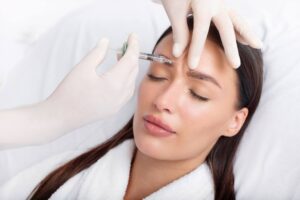Wouldn’t it be nice if there were an affordable, surgery-free, long-term solution for getting rid of those annoying pockets of fat that seem to hang on for dear life—no matter how clean you eat or how much you exercise?
We know this is going to sound too good to be true, but if you’re close to your goal weight and have a double chin, bra bulge, or a bit of extra fluff that just won’t budge, there actually is a way to say goodbye to this stubborn fat without going under the knife.
It’s called Kybella, a non-invasive prescription injectable medication that is FDA-approved for fat below the chin and is highly effective at reducing the appearance of a double chin. It is also used to successfully eliminate fat in other similar areas of the body.
While the results of Kybella aren’t as dramatic or instant as liposuction surgery, this popular injectable treatment is highly effective at improving the appearance of smaller fat pockets that seem to be resistant to diet and exercise.
In fact, in one clinical trial, 82.4 percent of people reported significantly improved satisfaction with their appearance after completing Kybella treatment.
In this article, we’ll break down everything you need to know about Kybella, including what it is, how it works, what to expect, who is and is not an ideal candidate, and if Kybella truly offers permanent results like many claims.
What is Kybella?
Kybella is a non-surgical FDA-approved medical aesthetic treatment that has the ability to target and kill fat cells. The main ingredient in the treatment is deoxycholic acid, a synthetic form of a naturally occurring bile acid in the body that aids in the breakdown and absorption of fat.
No surgery or incisions are required. Kybella is administered via injection, similar to neurotoxins like botox or dermal fillers. You are in and out of the office in less than an hour, and downtime is minimal to none in most cases.
Kybella injections are FDA-approved for and designed to address submental fullness, or as you and I know it, the under-chin fat commonly called a “double chin.” While it is only FDA-approved for reducing the appearance of a double chin, its applications extend to many other areas of stubborn fat as well.
Many practitioners successfully use Kybella “off-label” to treat small pockets of resistant fat in areas such as the bra line, jowls, armpit puffs, above the knees, stomach, and other localized fat bulges that don’t respond well to diet and exercise.
Unlike surgical methods such as liposuction, Kybella offers a non-invasive alternative that requires no incisions, anesthesia, or lengthy recovery periods. It is the perfect option if you want fat reduction without the price tag or downtime of surgery.
There are other non-surgical fat-reduction methods, such as fat freezing (CoolSculpting and similar procedures), but what sets Kybella apart from other cosmetic fat-reduction treatments is its ability to permanently destroy fat cells.
Yes, permanently! Once fat cells are eliminated with Kybella, they can no longer store or accumulate fat, resulting in a more contoured appearance in the treated area. However, there is a small caveat. We’ll discuss what “permanent results” means a little further down.
You cannot get Kybella over-the-counter, nor can you administer it yourself at home. Kybella treatments must be performed in a medical setting by qualified and specially trained healthcare professionals who understand facial and body anatomy and can deliver optimal results while minimizing potential side effects.
How Does Kybella Work to Eliminate Stubborn Fat?
Kybella’s active ingredient, deoxycholic acid, is a naturally occurring molecule in the body that plays a role in processing dietary fat. When injected into targeted fat deposits, Kybella works by disrupting fat cell membranes.
In short, this means Kybella essentially “melts away” the fat cells in the treated area. To get a little more specific, the deoxycholic acid causes a process of cellular breakdown in the treated area. This process, known as cytolysis, affects the membranes of fat cells in the injection site.
As these cells break down, the body’s natural metabolic processes gradually clear away the cellular debris over the following weeks. The treated fat cells, once disrupted, cannot regenerate or store fat again. This is what makes Kybella’s results potentially permanent for many patients, provided they maintain a stable weight through healthy lifestyle choices.
That’s the caveat to the claim that Kybella results are “permanent”, which we were talking about earlier. You can’t just get Kybella injections and then gain a lot of weight; you need to maintain your results with a healthy lifestyle.
It’s also important to understand that Kybella doesn’t prevent weight gain in untreated areas. We will discuss this more when we talk about the ideal candidate for Kybella injections, but for weight loss or overall weight management, patients might need to consider comprehensive approaches like proper diet, regular exercise, and possibly even medical weight loss drugs or other forms of peptide therapy for weight loss.
Results from Kybella develop gradually as your body processes the treated fat cells. The exact number of treatments needed varies depending on several factors, including the amount of fat present and your individual treatment goals.
Most patients notice improvement after only 2-4 Kybella treatment sessions; no more than six. We’ll discuss the entire process and how your Kybella injections are typically spaced out and follow-up treatments a little further down (spoiler: follow-up sessions are typically not needed once you’ve completed your custom treatment plan.)
What is Kybella Used For?
Kybella is used to target stubborn fat deposits that are resistant to diet and exercise. While only FDA-approved for treating fat under the chin, many qualified practitioners also use Kybella “off-label” to address other small, localized fat pockets throughout the body.
Off-label does not mean not safe; it simply means the FDA hasn’t specifically evaluated and approved the product for that particular use.
Using a product off-label is very common in medicine. There are thousands of medications and treatments that only have approval for specific conditions but are safely and successfully used for many others based on clinical experience and physician judgment.
The most common treatment areas that patients see success with Kybella include:
- Chin (submental fat)
- Jowls
- Armpit bulges
- Above the knees
- Small stomach bulges
- Small areas of back fat
- Buffalo hump (fat pad at the base of the neck)
- Banana rolls (the small fat deposit below the buttocks)
- Bra bulges (the small fat deposits that appear around the edges of a bra)
If you have another area of concern that is not listed, schedule a consultation to discuss whether Kybella might be appropriate for your specific needs.
Am I a Good Candidate for Kybella?
If you have small pockets of fat that stick around no matter how healthy you eat or how much you exercise—or are genetically predisposed to have a double chin or hold onto fat in certain small areas like your back or bra strap area—Kybella injections might be the perfect non-surgical fix you’ve been searching for.
That said, while Kybella offers impressive fat-reduction benefits for these stubborn spots, it’s important to have realistic expectations about what Kybella can achieve and understand that multiple sessions may be necessary to reach your desired results.
Additionally, Kybella is not recommended for everyone. Here are a few scenarios in which Kybella might not be the best option for you.
Kybella Is Not For Weight Loss or Obesity
First and foremost, Kybella is not intended for significant weight loss or as a treatment for obesity. The ideal candidate for Kybella is someone in generally good health, at or near a healthy weight, with moderate amounts of pinchable fat in the desired treatment area, and who is committed to maintaining their results with healthy lifestyle habits.
If you are struggling to lose weight despite diet and exercise, you might want to consider booking a consultation to discuss medical weight loss drugs such as Semaglutide. Or, your hormones could be to blame for your weight struggles.
If that is the situation, hormone replacement therapy (HRT) is often suggested as a safe and effective way to help restore hormone balance. However, in many cases, HRT may not be necessary for those who achieve weight loss through healthy lifestyle changes and/or medical weight loss drugs. Often, losing weight is all that’s needed to restore hormone balance.
However you go about getting to a healthy weight, once you are there or really close, if you still have stubborn fat pockets, you could then consider Kybella.
Kybella Should Not Be Used on Excessively Loose Skin
Kybella dissolves fat, but it cannot tighten loose skin. Therefore, people with good skin elasticity typically see the best results.
You can still benefit from Kybella even if your skin elasticity isn’t perfect, but if you have significantly lax or sagging skin, Kybella may not be the right treatment for you.
In fact, attempting to remove fat without first addressing skin laxity can make existing loose skin more noticeable.
If you have loose skin, you should address skin laxity first before considering a fat-dissolving treatment. For skin tightening concerns, other medical aesthetic treatments, such as laser,s may be more appropriate options.
Medical Reasons Where Kybella Might Not Be Right For You
There are also a few medical reasons Kybella might not be a safe option. Before considering Kybella fat-dissolving injections, you should consult with your healthcare provider if you’re:
- Pregnant
- Nursing
- Have an active infection in the treatment area
- Are taking certain medications like blood thinners
- If you’ve had previous surgical or cosmetic procedures in the area being treated
- Have medical conditions such as a bleeding disorder or difficulty swallowing (dysphagia)
Even if you don’t fall into any of these higher-risk categories, it’s essential to book a consultation with a qualified provider who specializes in fat-loss injection treatments.
During your appointment, your provider will assess your medical history, examine the treatment area, talk through your goals, and determine if Kybella is the right solution for you.
Does Kybella Have Any Side Effect Risks?
Kybella is FDA-approved and is considered safe for most patients—especially when a thorough medical history is taken into account, and a trained, experienced healthcare provider administers it.
Kybella has an excellent safety record, and most reported side effects are minor, temporary, and resolve on their own. These may include:
- Swelling
- Pain
- Numbness
- Redness
- Areas of hardness in the treatment area
You should always call your provider if any of these common symptoms linger longer than expected or worsen over time—just to be safe.
While rare, it’s important to be aware of potential (but more serious) side effects. These complications are uncommon—especially when Kybella is administered by a qualified professional in a proper clinical setting.
- Infection
- Trouble swallowing
- Open sores (ulcers)
- Hair loss at the injection site
- Bruising or blood pooling under the skin (hematoma)
- Damage to an artery or vein if injected improperly
- Tissue damage or cell death (necrosis) around the injection site
- Nerve injury in the jaw, which could cause an uneven smile or facial weakness
Again, these more severe side effects are rare and typically occur when the product is injected incorrectly or in patients with certain medical histories that raise their risk. That’s why it’s so important to receive Kybella injections from a skilled, medically licensed provider who specializes in aesthetic injectables and has specific training in Kybella.
Your risk of side effects can also increase with multiple treatments or if you don’t follow your pre- and post-procedure instructions. So be sure to follow all the guidelines your provider gives you and be open about any health concerns or medications during your consultation.
The Kybella Treatment Process: What to Expect Before, During and After Treatment
People love Kybella because it offers a quick, non-invasive solution to stubborn fat with minimal disruption to their busy lives. Unlike surgical fat reduction procedures, Kybella requires virtually no pre-treatment preparation and little to no downtime afterward.
If you are considering Kybella, you are probably curious about the Kybella treatment process. Here’s what to expect before, during, and after Kybella treatment, as well as a general idea of how long before you see the results of Kybella and any necessary maintenance required after your Kybella treatments.
Before Kybella Treatment
One of the perks of Kybella is how low-maintenance it is compared to other fat-dissolving treatments. While some procedures come with a laundry list of do’s and don’ts before you can undergo treatment, pre-treatment guidelines for Kybella are pretty simple.
Before your appointment, you might be advised to skip salty or sugary foods, alcohol, and caffeine a day or two before treatment to reduce the risk of swelling and/or bruising. Also, it’s generally advised to avoid blood-thinning or anti-inflammatory medications like aspirin or ibuprofen for at least a day or two, possibly longer.
Otherwise, there are typically no exercise restrictions, special diets, or other preparation instructions needed before Kybella injections.
During Kybella Treatment
When you arrive for your Kybella session, your provider will clean the treatment area thoroughly. A topical numbing cream may be applied to enhance your comfort, though many patients find the procedure painless and tolerable without it.
Your provider will then mark the injection sites, creating a customized grid pattern based on your unique anatomy and fat distribution.
A series of small injections will be administered directly into the fat layer beneath your skin. The number of injections varies based on the treatment area and your specific goals, but typically ranges from 20-50 injections per session.
The entire process usually takes only between 15-30 minutes, depending on the size of the treatment area.
After Kybella Treatment
There is minimal downtime and no significant recovery period after Kybella treatment. Once the treatment is finished, you can go home, back to work, and resume most of your normal activities.
You might experience some mild swelling, redness, bruising, firmness, and/or numbness in the treated area. Swelling is the most common side effect, which typically peaks 24-48 hours after treatment and may last several days to a week, gradually subsiding over time.
Most patients feel comfortable returning to work and social activities within 1-3 days, though visible swelling may last longer. Each subsequent treatment typically results in less swelling than the previous one.
Following your Kybella session, you’ll receive take-home instructions, which typically include:
- Applying ice to the area intermittently for the first 24-48 hours to reduce swelling
- Avoiding strenuous exercise for 24-48 hours
- Staying upright for at least 4 hours after treatment
- Avoiding massaging or manipulating the treated area
- Taking acetaminophen (Tylenol) as needed for any discomfort
It is also essential to stay hydrated following your treatment to support your body’s natural detoxification processes.
And, most importantly, to preserve your Kybella results long-term, you should maintain a stable weight through balanced nutrition and regular exercise.
Kybella Results and Maintenance
You aren’t going to walk out of your Kybella treatment and instantly notice that your stubborn fat has suddenly disappeared. You will need to have a little patience. Results from Kybella develop gradually as your body processes and eliminates the destroyed fat cells.
You may see changes after just one session, especially if you only have minimal fat to treat, but most patients do not begin to notice visible improvement after their second treatment session, with full results typically becoming apparent about 8–12 weeks after your final treatment.
The total number of sessions needed varies. Typically, 2–6 sessions spaced approximately 4–6 weeks apart are needed to achieve desired outcomes.
Then, for most patients, once they’ve completed their initial series of Kybella treatments and are satisfied with their results, no maintenance sessions are necessary—as long as they maintain a stable weight through healthy lifestyle choices.
Which brings us to the most commonly asked question about Kybella: Is Kybella permanent?
The answer is yes, but potentially no.
When it’s said that Kybella results are “permanent,” that means the fat cells destroyed by Kybella are permanently eliminated from your body and cannot regenerate. Once they’re gone, they’re gone for good.
However (and this is really important), the remaining fat cells in your body can still expand if you gain weight. The permanence of your results depends largely on what you do—or don’t do—after treatment.
If you are going to invest in Kybella and want the results to be long-lasting, you must be willing to commit to maintaining a healthy, consistent lifestyle. While the treated area will likely accumulate less fat than before (since there are fewer fat cells), significant weight gain can still affect your results.
The good news is, if you do experience weight fluctuations in the future that affect your results, or if you decide you’d like additional fat reduction in the treated area, touch-up treatments are always an option.
Where to Get Non-Surgical Kybella Fat Dissolving Injections
When considering Kybella treatments, the provider you choose is just as important as the treatment itself. While Kybella is FDA-approved and generally safe, the skill and experience of your injector significantly impact both your safety and your results.
Achieving optimal results with Kybella typically requires multiple sessions, so choose a provider you feel comfortable returning to and who takes time to understand your aesthetic goals.
Before booking your treatment, research potential providers thoroughly and look for or ask for:
- Proper credentials and specialized training in cosmetic injectables
- Extensive experience, specifically with Kybella treatments
- Before-and-after photos of actual patients
- Positive reviews and testimonials
- A clean, professional medical environment
- A thorough consultation process that includes discussing your medical history
Don’t hesitate to ask questions during your consultation, including specifics about the provider’s experience with Kybella, how many treatments they anticipate you’ll need, and what kind of results you can realistically expect based on your unique situation.
At Relieve Health, our experienced Kybella injectors will be transparent about the benefits and limitations of Kybella for your specific situation.
We will work with you to develop a comprehensive treatment plan that might even suggest a totally different treatment that is more suitable for your unique needs or complementary procedures if needed to help you achieve your desired outcome.
Use our clinic locator to find a Relive Health clinic near you and book your consultation today to find out if you are an ideal candidate for Kybella or if another medical aesthetic treatment is a better fit for your aesthetic concerns.




